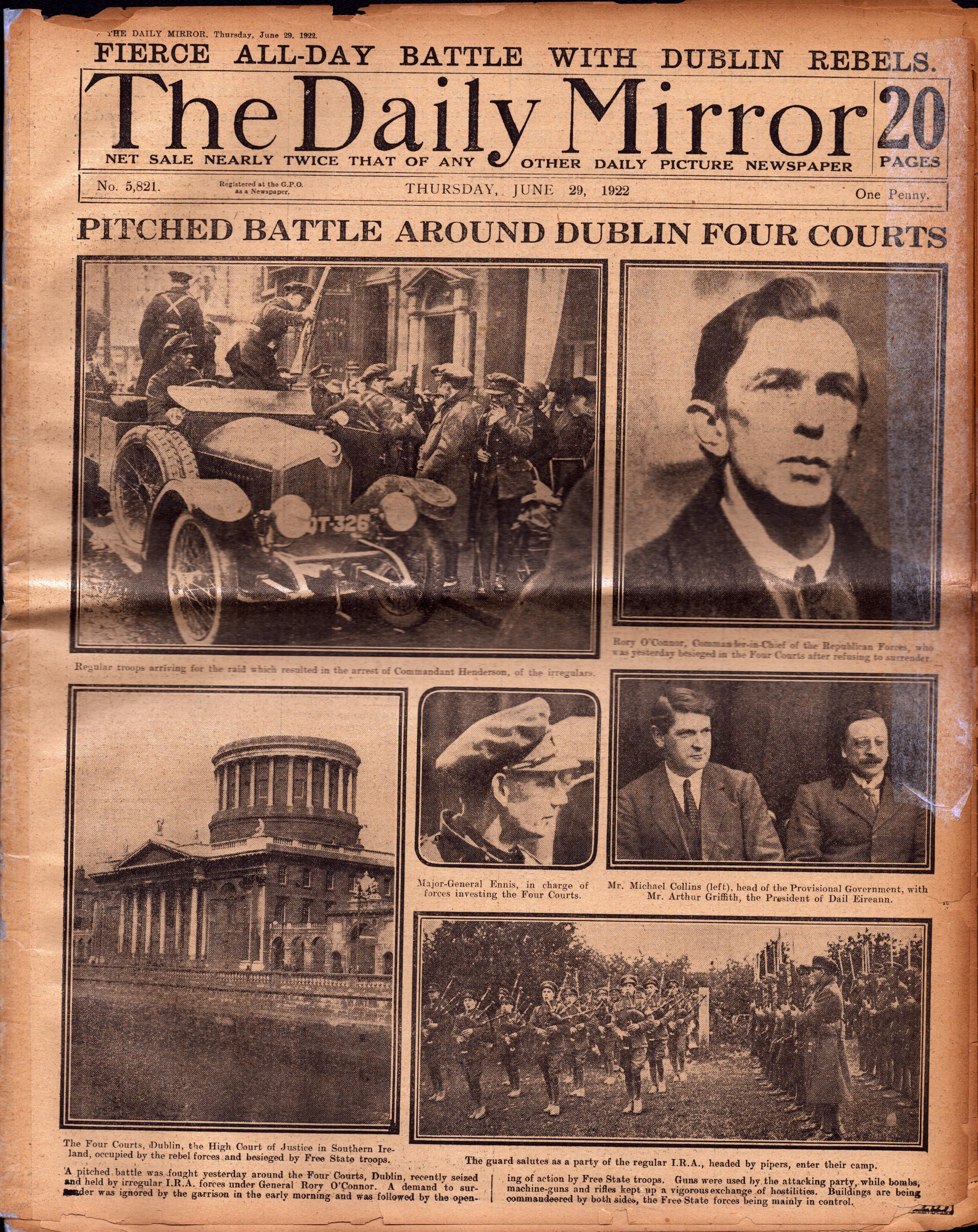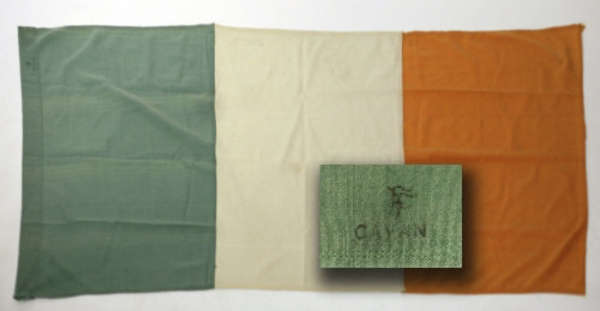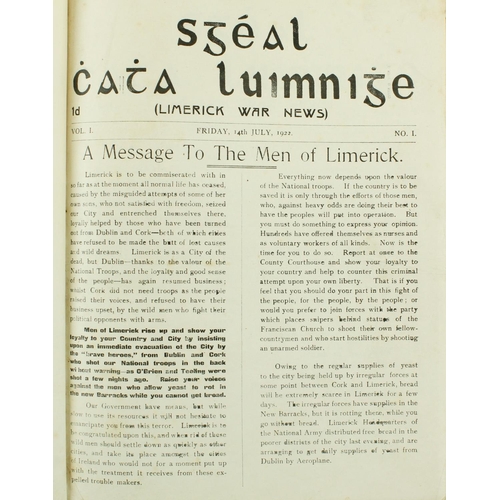AN IRISH CIVIL WAR PERIOD REPUBLICAN PRISONER OF WAR WORK PAINTING. Depicting the Teeling monument, erected on the site of the earlier Collooney battlefield, and titled ''The Monument of Telling (sic) on the Spot where he shot the Gunner in the 1798 Rebellion'', presentation inscription around ''Nicholas Mullan Rathnarrow, Ballymoate, captured at the fight of Collooney, July 14th 1922. Presented to Mrs Kelliner by a prisoner of war 1922 in return for her many kindnesses'' , signed W.J. Houston, Prisoner of War. In its original wooden frame, 16'' x 12'' (40cm x 30cm) horizontal approx. Another rare example of this short-lived Irish primitive genre, and an interesting association piece, linking as it does the two battles of Collooney. A depiction of site of the 1798 battle painted by a Republican Volunteer who took part in the 1922 battle of the same name. Nicholas Mullen and W.J. Houston were both taken prisoner at the action at Collooney on 14th July 1922 (see previous lot for details of that action). The Teeling Monument commemorates Bartholomew Teeling (1774-1798) and his gallantry during the battle that took place at Collooney in1798. The son of a Lisburn linen-draper, Teeling joined the United Irishmen and went to France in 1796 to assist Wolfe Tone with his plans for a French invasion of Ireland. He landed at Killala in 1798 as a aide-de-camp to General Humbert, and was present with Humbert at Castlebar, 27th August 1798, when he defeated an army of 1,700 militia and regulars under General Lake. Teeling played a decisive part at the battle of Collooney, 5th September 1798, when General Humbert and his army defeated a force under Colonel Vereker comprising some 250 men of the Limerick Militia, 50 yeomanry, 20 men of the 24th Light Dragoons and two artillery pieces. At the height of the battle the Franco-Irish attack was held up by fire from one of the loyalist artillery pieces, under the command of a highly talented gunner by the name of Whitters. In a remarkable feat of individual bravery, Teeling galloped alone towards the loyalist artillery piece, pistolled Whitters at point-blank range and rode back to the rebel lines unscathed through a hail of musket fire. Inspired by this example, the Irish and their French allies surged forward and routed the loyalists. Teeling was captured following the Franco-Irish defeat at Ballinamuck, court martialed at Dublin, sentenced to death, and hanged at Arbour Hill barracks on 24th September 1798. AN IRISH CIVIL WAR PERIOD REPUBLICAN PRISONER OF WAR WORK PAINTING. Depicting the Teeling monument, erected on the site of the earlier Collooney battlefield, and titled ''The Monument of Telling (sic) on the Spot where he shot the Gunner in the 1798 Rebellion'', presentation inscription around ''Nicholas Mullan Rathnarrow, Ballymoate, captured at the fight of Collooney, July 14th 1922. Presented to Mrs Kelliner by a prisoner of war 1922 in return for her many kindnesses'' , signed W.J. Houston, Prisoner of War. In its original wooden frame, 16'' x 12'' (40cm x 30cm) horizontal approx. Another rare example of this short-lived Irish primitive genre, and an interesting association piece, linking as it does the two battles of Collooney. A depiction of site of the 1798 battle painted by a Republican Volunteer who took part in the 1922 battle of the same name. Nicholas Mullen and W.J. Houston were both taken prisoner at the action at Collooney on 14th July 1922 (see previous lot for details of that action). The Teeling Monument commemorates Bartholomew Teeling (1774-1798) and his gallantry during the battle that took place at Collooney in1798. The son of a Lisburn linen-draper, Teeling joined the United Irishmen and went to France in 1796 to assist Wolfe Tone with his plans for a French invasion of Ireland. He landed at Killala in 1798 as a aide-de-camp to General Humbert, and was present with Humbert at Castlebar, 27th August 1798, when he defeated an army of 1,700 militia and regulars under Ge
AN IRISH CIVIL WAR PERIOD REPUBLICAN PRISONER OF WAR WORK PAINTING. Depicting the Teeling monument, erected on the site of the earlier Collooney battlefield, and titled ''The Monument of Telling (sic) on the Spot where he shot the Gunner in the 1798 Rebellion'', presentation inscription around ''Nicholas Mullan Rathnarrow, Ballymoate, captured at the fight of Collooney, July 14th 1922. Presented to Mrs Kelliner by a prisoner of war 1922 in return for her many kindnesses'' , signed W.J. Houston, Prisoner of War. In its original wooden frame, 16'' x 12'' (40cm x 30cm) horizontal approx. Another rare example of this short-lived Irish primitive genre, and an interesting association piece, linking as it does the two battles of Collooney. A depiction of site of the 1798 battle painted by a Republican Volunteer who took part in the 1922 battle of the same name. Nicholas Mullen and W.J. Houston were both taken prisoner at the action at Collooney on 14th July 1922 (see previous lot for details of that action). The Teeling Monument commemorates Bartholomew Teeling (1774-1798) and his gallantry during the battle that took place at Collooney in1798. The son of a Lisburn linen-draper, Teeling joined the United Irishmen and went to France in 1796 to assist Wolfe Tone with his plans for a French invasion of Ireland. He landed at Killala in 1798 as a aide-de-camp to General Humbert, and was present with Humbert at Castlebar, 27th August 1798, when he defeated an army of 1,700 militia and regulars under General Lake. Teeling played a decisive part at the battle of Collooney, 5th September 1798, when General Humbert and his army defeated a force under Colonel Vereker comprising some 250 men of the Limerick Militia, 50 yeomanry, 20 men of the 24th Light Dragoons and two artillery pieces. At the height of the battle the Franco-Irish attack was held up by fire from one of the loyalist artillery pieces, under the command of a highly talented gunner by the name of Whitters. In a remarkable feat of individual bravery, Teeling galloped alone towards the loyalist artillery piece, pistolled Whitters at point-blank range and rode back to the rebel lines unscathed through a hail of musket fire. Inspired by this example, the Irish and their French allies surged forward and routed the loyalists. Teeling was captured following the Franco-Irish defeat at Ballinamuck, court martialed at Dublin, sentenced to death, and hanged at Arbour Hill barracks on 24th September 1798. AN IRISH CIVIL WAR PERIOD REPUBLICAN PRISONER OF WAR WORK PAINTING. Depicting the Teeling monument, erected on the site of the earlier Collooney battlefield, and titled ''The Monument of Telling (sic) on the Spot where he shot the Gunner in the 1798 Rebellion'', presentation inscription around ''Nicholas Mullan Rathnarrow, Ballymoate, captured at the fight of Collooney, July 14th 1922. Presented to Mrs Kelliner by a prisoner of war 1922 in return for her many kindnesses'' , signed W.J. Houston, Prisoner of War. In its original wooden frame, 16'' x 12'' (40cm x 30cm) horizontal approx. Another rare example of this short-lived Irish primitive genre, and an interesting association piece, linking as it does the two battles of Collooney. A depiction of site of the 1798 battle painted by a Republican Volunteer who took part in the 1922 battle of the same name. Nicholas Mullen and W.J. Houston were both taken prisoner at the action at Collooney on 14th July 1922 (see previous lot for details of that action). The Teeling Monument commemorates Bartholomew Teeling (1774-1798) and his gallantry during the battle that took place at Collooney in1798. The son of a Lisburn linen-draper, Teeling joined the United Irishmen and went to France in 1796 to assist Wolfe Tone with his plans for a French invasion of Ireland. He landed at Killala in 1798 as a aide-de-camp to General Humbert, and was present with Humbert at Castlebar, 27th August 1798, when he defeated an army of 1,700 militia and regulars under Ge














Testen Sie LotSearch und seine Premium-Features 7 Tage - ohne Kosten!
Lassen Sie sich automatisch über neue Objekte in kommenden Auktionen benachrichtigen.
Suchauftrag anlegen